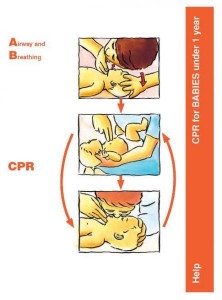CPR
First Aid and CPR (rescue breathing and chest compressions)
All caregivers should know how to perform CPR. Courses are run locally by St John, Red Cross and other training organisations.
Rescue breathing and chest compressions are only for a child who is not breathing.
This may happen because the child has:
- had an electric shock (turn off the power first before touching the child)
- breathed in water or smoke.
They may have gone blue in the face.
What should you do first?
- Shake (not too hard) and shout to the child to try to wake them up.
- Call for help.
- Open airway.
If they are not breathing, follow the DRS ABC sequence:
D Dangers
R Responsiveness
S Send for Help
A Open Airway
B Breathing – 2 Breaths
C Chest Compressions – 30 compressions
Learn before you need it
CPR for babies under 1 year – in an emergency only 
Airway –
- Put the baby on their back on a firm, flat surface, e.g. a table
- Open the airway with a gentle head tilt and chin lift. Do not tilt the head back too far. Lift the chin gently with your fingers.
Breathing –
- Look, listen and feel for breathing (look for chest movement, listen for sounds of airflow around the mouth and feel for air against your cheek.)
- If they are breathing, place the baby on their side.
- If they are not breathing and you are alone, leave the infant or carry them with you to get help. Dial 111 and ask for an ambulance. Then start chest compressions.
Chest compressions –
- Place two fingers just below an imaginary line joining the nipples, press down 1/3 of the depth of the chest at a rate of 100 times a minute.
- After every 30 compressions, open the airway using the head tilt and chin lift.
- Form a tight seal with your mouth over the baby’s nose or around the baby’s nose and mouth and give the baby 2 breaths, just enough to see their chest rise and fall.
- Repeat the cycle of 30 chest compressions and 2 breaths.
- Keep going until help arrives or they start breathing on their own.
CPR for children over 1 year
Airway –
- Place the child on their back on a firm, flat surface, e.g. the floor.
- Open the airway using the head tilt-chin lift: tilt the head back and lift the chin forward with your fingers.
Breathing –
- Look, listen and feel for breathing – look for chest movement, listen for sounds of airflow around the mouth and feel for air against your cheek.
- If they are breathing, place the child in the recovery position.
- If the child is not breathing and you are alone, leave the child and go and get help. Call 111 and ask for an ambulance. On return, start chest compressions.
Chest compressions –
- Place the heel of one hand over the lower half of the breastbone, press down 1/3 the depth of the chest at a rate of 100 times a minute.
- After every 30 chest compressions, open the airway using the head tilt and chin lift.
- Pinch the nose, form a tight seal around the child’s mouth with your mouth, just enough to see their chest rise and fall.
- Repeat the cycle of 30 chest compressions and 2 breaths.
- Keep going until help arrives or they start breathing on their own.

